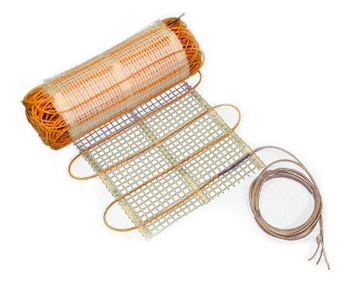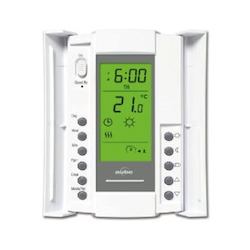Electric Radiant Heat
Using electric radiant heat has several advantages over more conventional forced-air heating systems:
it is typically more efficient than forced-air heat because there is no energy loss through ducts.
Radiant heat doesn't require moving air through a space, which can be helpful for people with asthma or allergy issues.
One of the more popular types of Electric Radiant Heat used in residential homes is electric floor heating. Electric radiant floor heat systems usually consist of electrical cables built directly into the floor.
Other types of electric floor systems use mats or grids of electrically-conductive materials which are mounted onto (or even under) the subfloor, beneath the floor covering.
Electricity rates are typically quite high in many areas, so in order to make electric radiant floor heat cost-effective, they should be used in a flooring that has a high thermal mass, such as concrete.
The thermal mass of the floor will "store" the heat given off by the electric cables or mats, and radiate that heat into the room space above gradually, over time.
If your electric utility offers time-of-use rates, you can charge the floor with electricity during off-peak hours (usually at night).
The heat stored in the thermal mass of the flooring itself can keep the space at comfortable temperatures for up to 8 or 10 hours without further electricity usage.
Installing Electric Radiant Heat in New or Retrofitting Existing Homes:
As mentioned above, electric radiant floor heat can work well when used in flooring with a high thermal mass such as concrete. Installing these types of floors is typically only feasible during construction of a new home. However, electric radiant floor heat also remains a popular option for existing home renovation or additions, where installing a new concrete flooring, or extending existing heat systems into an addition aren't possible, or cost-effective.
For retrofitting an existing home with electric radiant heat, electric mesh mats or wires can easily be installed directly under the floor covering, or cables can be sandwiched between the concrete or wood subfloor and the plywood or concrete floor underlayment.
In a home retrofit, Electric Radiant Floor Heat can also be installed on the underside of the sub-flooring, if it's accessible from below. Installing the electric radiant heat system this way leaves it accessible for future renovations or repairs. This type of installation involves hanging electric radiant heating elements from the underside of the subfloor in the spaces between the floor joists. Insulation or metal plating can be installed below the electric heat system to reflect the heat upwards into the room above, further increasing its' effectiveness.
comments powered by Disqus



























































































































































































